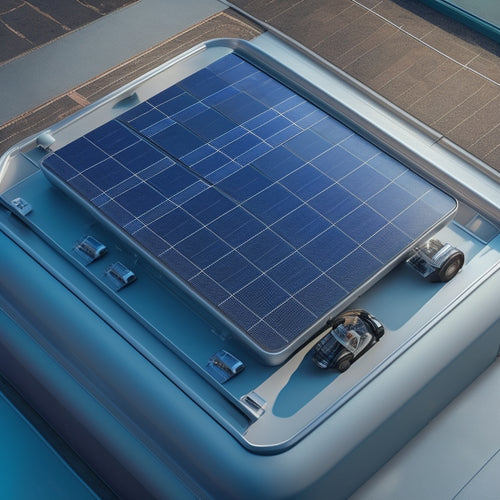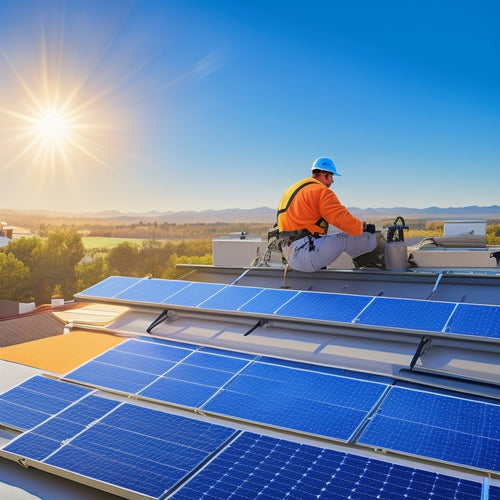
10 Renewable Energy Solutions for Eco-Friendly Warehouses
Share
You're looking to transform your warehouse into an eco-friendly hub by incorporating renewable energy solutions. You can start by exploring solar panel installation benefits, wind turbine power generation, and geothermal energy systems. Biomass energy storage systems, green roofing, and insulation can also help reduce your carbon footprint. Rainwater harvesting systems and biogas fuel cell technology are other alternatives to explore. Additionally, energy recovery ventilation systems and hydrogen fuel cell applications can help you achieve a more sustainable warehouse. By exploring these options, you'll be well on your way to creating a more environmentally friendly warehouse - and there's even more to discover.
Key Takeaways
• Implement solar panel installation to reduce carbon footprint and energy costs, with minimal maintenance required.
• Utilize wind turbine power generation, optimized through wind speed analysis and regular maintenance checks.
• Leverage geothermal energy systems for a reliable, clean, and consistent source of power, unaffected by weather patterns.
• Integrate biogas fuel cell technology to generate electricity efficiently and sustainably, using farm waste as a renewable resource.
• Consider hydrogen fuel cell applications for efficient, clean, and quiet electricity generation with zero emissions.
Solar Panel Installation Benefits
By investing in solar panel installation, you can substantially reduce your reliance on fossil fuels and lower your carbon footprint.
This eco-friendly approach not only benefits the environment but also leads to significant energy savings. A well-designed solar panel system can offset a substantial portion of your energy consumption, resulting in lower electricity bills.
Furthermore, solar panels require minimal maintenance, guaranteeing a hassle-free experience. Regular cleaning and inspections are vital to achieve peak performance, but these tasks are relatively simple and infrequent.
When designing your solar panel system, it's crucial to take into account factors like roof size, orientation, and local building codes.
A well-designed system guarantees maximum energy production and efficiency. Additionally, many governments offer incentives for businesses shifting to renewable energy sources, making the investment even more attractive.
Wind Turbine Power Generation
As you explore alternative energy sources, wind turbine power generation emerges as a viable solution, offering a clean and efficient way to harness the kinetic energy of wind. Wind turbines convert wind energy into electrical energy, making it an attractive option for eco-friendly warehouses. To facilitate peak performance, wind speed analysis is vital in identifying suitable locations and optimizing turbine placement.
| Wind Speed Analysis | Turbine Maintenance |
|---|---|
| Analyze wind speed and direction | Regularly inspect and clean blades |
| Identify ideal turbine locations | Perform routine lubrication and wear checks |
| Maximize turbine placement | Schedule regular maintenance checks |
Geothermal Energy Systems
You can tap into the Earth's internal heat with geothermal energy systems, which leverage the natural warmth beneath the surface to generate electricity, providing a reliable and clean alternative to traditional fossil fuels.
By harnessing the Earth's internal heat, you can reduce your warehouse's carbon footprint and reliance on non-renewable energy sources.
Three benefits of geothermal energy systems are:
-
Stable temperatures: Earth temperatures remain relatively constant, ranging from 40°F to 70°F (4°C to 21°C), making them ideal for heat pumps to generate electricity.
-
Low emissions: Geothermal energy systems produce minimal greenhouse gas emissions, making them an attractive option for eco-friendly warehouses.
-
Reliability: Geothermal energy is a consistent source of power, unaffected by weather patterns or seasonal changes, ensuring a stable supply of electricity.
Heat pumps play a vital role in geothermal energy systems, converting the Earth's heat into usable electricity.
Biomass Energy Storage Systems
Biomass energy storage systems effectively capture and store energy generated from organic matter, such as wood waste, agricultural residues, and wastewater, providing a renewable alternative to fossil fuels.
As you consider incorporating biomass energy into your warehouse operations, you must understand the logistics involved in collecting, processing, and storing biomass fuels. This includes ensuring a reliable supply chain, managing fuel quality, and optimizing storage facilities to minimize degradation.
| Biomass Source | Energy Potential | Carbon Sequestration Benefit |
| Wood Waste | 3.5 kWh/kg | 2.5 kg CO2e/kg |
| Agricultural Residues | 4.2 kWh/kg | 3.1 kg CO2e/kg |
| Wastewater | 2.8 kWh/kg | 1.9 kg CO2e/kg |
| Forestry Residues | 3.8 kWh/kg | 2.8 kg CO2e/kg |
| Municipal Solid Waste | 2.2 kWh/kg | 1.5 kg CO2e/kg |
Green Roofing and Insulation
As you explore green roofing and insulation solutions, you'll want to examine the thermal mass benefits that come with integrating natural materials into your building design.
You'll also need to select insulation materials that balance energy efficiency with environmental sustainability.
Thermal Mass Benefits
Thermal mass, a crucial component of green roofing and insulation, helps regulate building temperatures by absorbing and releasing heat, thereby reducing the need for heating and cooling systems. As you design your eco-friendly warehouse, incorporating thermal mass into your structural integration will have a significant impact on climate regulation. By doing so, you'll reduce your reliance on HVAC systems, leading to significant energy savings.
Three key benefits of thermal mass integration are:
-
Temperature stabilization: Thermal mass absorbs excess heat during the day and releases it at night, maintaining a consistent indoor temperature.
-
Energy efficiency: By reducing the need for heating and cooling, you'll lower your energy consumption and carbon footprint.
-
Improved indoor air quality: Thermal mass helps regulate humidity levels, creating a healthier and more comfortable indoor environment.
Insulation Material Options
You'll find a range of eco-friendly insulation materials to choose from, each with its unique characteristics, advantages, and environmental benefits.
When selecting the right insulation for your eco-friendly warehouse, consider factors such as R-value, durability, and sustainability.
Fiberglass, a popular choice, boasts excellent thermal insulation properties and is relatively inexpensive. Its high R-value facilitates efficient heat retention, reducing energy consumption and carbon emissions. Additionally, fiberglass is recyclable and non-toxic, making it an environmentally friendly option.
Spray foam insulation, on the other hand, offers superior benefits, including high R-values, air-tightness, and moisture resistance. Its unique properties make it ideal for warehouses with complex geometries or hard-to-reach areas. Spray foam benefits also include reduced air leakage, minimizing heat loss and energy waste.
When choosing between these eco-friendly insulation materials, consider your warehouse's specific needs and climate. By selecting the right insulation, you'll not only reduce your carbon footprint but also create a more comfortable, energy-efficient working environment for your employees.
Energy-Efficient Lighting Solutions
Implementing energy-efficient lighting solutions can substantially reduce your energy consumption and lower your carbon footprint. As you shift to eco-friendly warehousing, it's crucial to explore alternatives that not only benefit the environment but also your bottom line.
When it comes to energy-efficient lighting, you have several options to weigh:
-
LED alternatives: Replace traditional lighting with LED bulbs, which consume much less energy and last longer.
-
Smart fixtures: Install smart lighting systems that can adjust brightness and color based on natural light availability, occupancy, and time of day.
-
Occupancy sensors: Implement motion sensors to turn lights off when areas are unoccupied, reducing unnecessary energy consumption.
Rainwater Harvesting Systems
As you explore rainwater harvesting systems, you'll encounter two essential components: water storage systems and roof catchment areas.
You'll need to examine the capacity and material of your storage system, as well as its placement and maintenance requirements.
Meanwhile, the design and size of your roof catchment area will impact the amount of rainfall you can collect and utilize.
Water Storage Systems
Collecting and storing rainwater through water storage systems, also known as rainwater harvesting systems, offers a sustainable solution for reducing dependence on municipal water supplies.
As you implement this eco-friendly approach, you'll need to think about the quality of the collected water and the materials used for storage.
Key Factors to Think About:
Water Quality: Verify the water is free from contaminants and debris. Regular maintenance and cleaning of the storage system will help maintain prime water quality.
Tank Materials: Choose durable, corrosion-resistant materials that won't react with the stored water. Stainless steel, concrete, and fiberglass are popular options.
System Sizing: Calculate the storage capacity based on your warehouse's water needs and the local rainfall patterns to guarantee a consistent supply.
Roof Catchment Areas
Your roof catchment area, the surface that funnels rainwater towards your harvesting system, plays a vital role in determining the overall efficiency of your rainwater harvesting setup. A well-designed roof catchment area can significantly increase the amount of rainwater collected, reducing your reliance on municipal water supplies and lowering your water bills.
When designing your roof catchment area, consider the following factors:
| Factor | Considerations |
|---|---|
| Roof Material | Choose a material that is resistant to corrosion and can withstand harsh weather conditions. |
| Roof Slope | A steeper slope can improve water flow, but may require additional structural support. |
| Rooftop Gardens | Integrate rooftop gardens to reduce stormwater runoff and increase biodiversity. |
| Drainage Systems | Ensure proper drainage systems are in place to prevent waterlogging and erosion. |
Biogas Fuel Cell Technology
You can generate electricity efficiently by utilizing biogas fuel cell technology, which converts chemical energy from biogas into electrical energy through electrochemical reactions.
This innovative technology has the potential to power your eco-friendly warehouse sustainably. Biogas, typically derived from farm waste, undergoes anaerobic conversion, where microbial interactions break down organic matter to produce a combustible gas mixture.
This biogas is then purified to enhance its energy content, guaranteeing maximum fuel efficiency.
To maximize the benefits of biogas fuel cell technology, consider the following key factors:
Feedstock selection: Choose the right farm waste for anaerobic conversion to facilitate high-quality biogas production.
Gas purification: Implement an efficient purification process to remove impurities and boost the energy content of the biogas.
System design: Optimize your biogas fuel cell system design to guarantee maximum fuel efficiency and electricity generation.
Energy Recovery Ventilation Systems
As you explore energy recovery ventilation systems, you'll discover the significant benefits they bring to the table.
By integrating these systems into your building design, you'll experience a boost in energy efficiency, thanks to the heat recovery benefits.
In addition, you'll enjoy improved indoor air quality through fresh air circulation, making your space a healthier and more comfortable environment.
Energy Efficiency Boost
Energy Recovery Ventilation (ERV) systems can recover up to 80% of the energy that would otherwise be lost during ventilation, substantially reducing the building's overall energy consumption. By incorporating ERV systems into your warehouse, you can markedly boost energy efficiency.
But how can you guarantee that your ERV system is running at its best?
Conduct regular Energy Audits to identify areas of improvement and optimize system performance.
Implement Energy Monitoring systems to track energy usage and identify opportunities for reduction.
Perform routine maintenance to certify that your ERV system is running at peak efficiency.
Fresh Air Circulation
By incorporating energy recovery ventilation (ERV) systems into your warehouse, you can optimize fresh air circulation while minimizing energy waste. ERV systems work by transferring heat and moisture from exhaust air to fresh air, reducing the energy required to heat or cool the air. This results in improved indoor air quality and a significant reduction in energy consumption.
| Benefits | Description | Advantages |
|---|---|---|
| Improved Air Quality | Removes pollutants and particles from the air | Healthier work environment |
| Energy Efficiency | Recovers heat and moisture from exhaust air | Reduces energy consumption |
| Increased Ventilation | Provides a consistent flow of fresh air | Boosts productivity and comfort |
| Reduced Moisture | Removes excess moisture from the air | Prevents mold and mildew growth |
| Cost Savings | Reduces energy costs and extends HVAC system life | Increases profitability |
Heat Recovery Benefits
You can reap significant heat recovery benefits from incorporating energy recovery ventilation (ERV) systems into your warehouse, which can translate to a whopping 60-80% reduction in heating and cooling energy consumption.
ERV systems work by capturing the heat energy from exhaust air and transferring it to fresh air using a heat exchanger. This heat recovery process reduces the load on your HVAC system, resulting in substantial energy savings.
Three key benefits of heat recovery ventilation systems are:
Energy Efficiency: ERV systems minimize the energy required to heat or cool your warehouse, reducing your energy bills and carbon footprint.
Improved Indoor Air Quality: By recovering heat energy from exhaust air, ERV systems provide a consistent supply of fresh air, creating a healthier and more comfortable working environment.
Reduced Maintenance: With ERV systems, your HVAC equipment lasts longer and requires less maintenance, as they're not working as hard to heat or cool your warehouse.
Hydrogen Fuel Cell Applications
In the pursuit of reducing greenhouse gas emissions, hydrogen fuel cell applications have emerged as a promising solution for powering transportation, industrial processes, and even entire communities. As you explore this technology, you'll find that fuel cells offer a clean and efficient way to generate electricity. But what makes them so appealing?
| Aspect | Benefits | Challenges |
|---|---|---|
| Fuel Cell Safety | Zero emissions, quiet operation | High-pressure hydrogen storage risks |
| Hydrogen Infrastructure | Expanding network of fueling stations | Limited availability, high upfront costs |
| Energy Efficiency | 40-60% efficient, compared to 20-30% for fossil fuels | Dependence on renewable energy sources |
You'll notice that fuel cell safety is a top concern, with the risk of high-pressure hydrogen storage accidents. However, the benefits of zero emissions and quiet operation make them an attractive option. As the hydrogen infrastructure continues to expand, you can expect to see more widespread adoption of fuel cell technology. With their high energy efficiency, it's no wonder they're being considered for powering everything from warehouses to entire communities.
Frequently Asked Questions
Can Existing Warehouses Be Retrofitted for Renewable Energy Systems?
You can retrofit existing warehouses for renewable energy systems, but first, you'll need to conduct energy audits, assess the building envelope and structural integrity, optimize the facility layout, select sustainable materials, and navigate the permitting process.
How Long Does It Take to See a Return on Investment in Renewable Energy?
You'll typically see an energy payback within 5-7 years, depending on financial projections, but this timeframe varies based on factors like system costs, energy savings, and local incentives that impact your return on investment.
Are Renewable Energy Solutions Compatible With Existing Building Management Systems?
When integrating renewable energy solutions, you'll find that system integration and data compatibility are vital. You'll need to verify your existing building management system can seamlessly communicate with the new renewable energy system, sharing data and optimizing performance.
Can Renewable Energy Systems Be Integrated With Existing HVAC Systems?
You'll find that integrating renewable energy systems with existing HVAC systems is possible, but it requires careful system sizing and energy storage planning to ensure a seamless and efficient transition.
Are There Government Incentives for Implementing Renewable Energy Solutions?
You'll find government incentives abound, offering tax credits and grant opportunities to offset implementation costs, making your eco-friendly endeavors more affordable and financially attractive, so it's worth exploring these benefits before making a move.
Related Posts
-

Top Solar Panels for Car Battery Maintenance
When selecting top solar panels for car battery maintenance, consider high-efficiency models with high wattage output...
-

Planning for an Electric Vehicle-Friendly Urban Future
As you plan for an electric vehicle-friendly urban future, you'll need to integrate high-power charging stations, sma...
-

3 Essential Steps for Solar Electricity Installation
To guarantee a successful solar electricity installation, you'll need to follow three essential steps. First, assess ...


